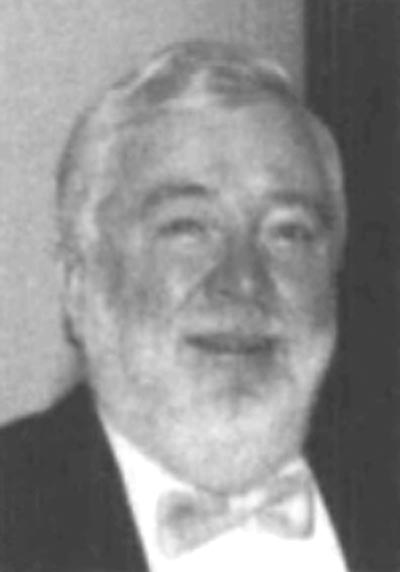
(b. 1924)
Emerson Moffitt, who was born on September 9, 1924, in McAdam, New Brunswick, was marked for success ever since his days at high school, where he won a Governor-general's award for high academic standing. He found he liked science and decided to become a doctor. Fortunately for the specialty he was attracted to anesthesiology, and he soon found his metier in research into the effects of anesthesia on the heart. In this he was highly successful, and because of his career-long success in this field we have a greater understanding of the behaviour of the heart under anesthesia.
Dr Moffitt took his premedical course at the University of New Brunswick, though it was interrupted by service in the Royal Naval Fleet Air Arm. He enrolled in medicine at Dalhousie University and, after graduating in 1951, he did three years in general practice in North Sydney. This gave him an introduction to anesthesia and an interest in the specialty. As some friends were taking residencies at the Mayo Clinic, he went there, too.
He worked with such luminaries as J.S. Lundy, who was the first to use sodium pentothal, and Earl Wood and Jeremy Swan in the study of cardiac physiology. Wood and Swan were part of a team, headed by John Kirklin, participating in the study of the first children who were undergoing whole-body perfusion for open-heart surgery; Emerson took part in this pioneering work. He thus contributed to the first successful series of operations in this challenging field, and it led him, over the next 35 years, first at the Mayo Clinic and later at Dalhousie University, to devote his career to furthering his understanding of various aspects of the heart's response to the physiological trespass imposed by surgery on the cardiovascular system. The signal success of this endeavour is evident from the numerous grants he was awarded, the many papers he published, the multiplicity of lectureships and visiting professorships he held, and the variety of honours bestowed on him.
A highlight of his career at the Mayo Clinic include membership in the research society of the Sigma XI, while in Canada he was honoured by being awarded the Gold Medal of the Canadian Anaesthetists’ Society in 1990. Emerson was chairman of the Board of Trusteees of the International Anesthesia Research Society from 1979 to 1980 and its Executive Secretary from 1983 to 1990, and he was associate editor of Anesthesia and Analgesia from 1973 to 1977; and he was president of the Academy of Anesthesiology in 1978-79. He was awarded senior membership of the Canadian Medical Association, and he is a recipient of the Distinguished Service Award of the Medical Society of Nova Scotia.
When Emerson Moffitt returned to Canada in 1972, he was first the Research Professor of Anaesthesia at Dalhousie and then Professor of Anaesthesia and Head of the Department. He continued his work as a cardiac anesthesiologist and researcher, and a productive sabbatical in 1979 and 1980 with Swan and Willie Ganz (on coronary sinus catheterization) at the Cedars-Sinai Hospital in Los Angeles added to his already profound knowledge of this highly specialized field. By the time he retired from Dalhousie University in 1991, Emerson Moffitt had amassed a total of 203 publications, many of great interest to anesthesiologists practicing cardiac anesthesia and many others to basic scientists.
Although Dr Moffitt's chief contributions lay in cardiac research, he did much for organizational aspects of the profession and speciality. At Dalhousie University he rejuvenated the anaesthesia department by attracting teachers and clinicians at a time when anesthesiology departments lacked Canadian graduates. The high standing of the Dalhousie department is a result largely of his success in meeting the challenge of building up the department in the 1970s. Appropriately his name is remembered in the research fund that the anesthesia department set up in his name, so that prizes could be awarded to medical students and anesthesia trainees. From 1980 to 1986 Emerson also assisted Dean J.D. Hatcher, a physiologist, as Associate Dean for Clinical Affairs. As well, he also greatly assisted the Dalhousie Medical Alumni Association, as development officer and as editor of the Association's journal, Vox MeDAL, continuing in the latter post until1994, three years after he had retired.
Dr Moffitt also did a great deal for anesthesia in Nova Scotia as a whole. He chaired an advisory committee that developed guidelines for the practice of anesthesia in Nova Scotia, the first province in Canada to formulate such guidelines. These include two years of formal training for physicians seeking anesthesia privileges in community hospitals. Later, he coordinated a program that made reviews, on request, of anesthesia services in hospitals throughout the province.
The Canadian Anesthesiologists' Society, too, benefitted from Emerson's counsel and contributions. As a member of the Committee on Scientific Affairs he did much to revivify the annual meeting, particularly in introducing the refresher courses in 1979. From 1973 to 1982 he served on the editorial board of the Society's journal, and in 1987 he gave the Royal College Lecture at the annual meeting, when he spoke on myocardial oxygenation.
Dr Moffitt presently enjoys a well-earned retirement in Halifax with his wife Isabel, formerly of Truro, Nova Scotia (his first wife, Helen, died in 1971, and his second, Phyllis, in 1987). He has three children, Eric, Celene, and Laurie. His retirement, however, does not prevent "Moff'' from taking a continuing interest in our specialty and in the Society, which salutes an anesthesiologist who made unique contributions during his distinguished career.
Note: Dr Moffitt passed away April 30, 2011
David A.E. Shephard MB FRCPC, Charlottetown, PEI
CAN J ANESTH 1999 / 46:12 / pp 1191-1192